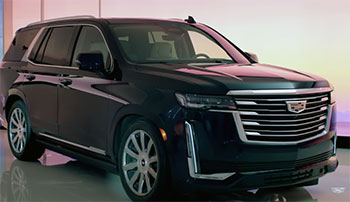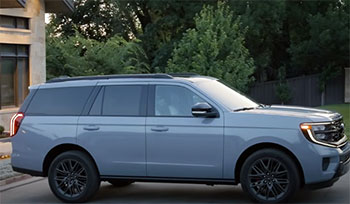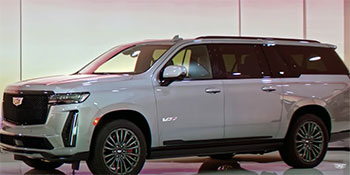I’ve always been fascinated by full-size SUVs—those massive, family-hauling, road-dominating beasts that promise comfort, power, and versatility. So, when I set out to compare the 2025 Cadillac Escalade and the 2025 Ford Expedition, I wanted to see which one truly delivers for someone like me: a driver who craves luxury but needs practicality for family life, road trips, and the occasional towing adventure.
This article breaks down my experience with both, weighing their strengths and weaknesses to help you decide which SUV fits your lifestyle. From tech to towing, I’ll cover it all with a comparison table, pros, cons, and answers to common questions.
ComparisonTable: Cadillac Escalade Vs. Ford Expedition
| Feature | Cadillac Escalade | Ford Expedition |
|---|---|---|
| Starting MSRP | $89,795 | $63,191 |
| Engine | 6.2L V8 (420 hp, 460 lb-ft) | 3.5L Twin-Turbo V6 (380 hp, 480 lb-ft) |
| Fuel Economy | 14 MPG city / 19 MPG highway | 16 MPG city / 24 MPG highway |
| Towing Capacity | 8,200 lbs | 9,600 lbs |
| Cargo Space | 25.5 cu.ft. (rear seats up), 120.5 cu.ft. (max) | 63.6 cu.ft. (rear seats up), 120.5 cu.ft. (max) |
| Seating | Up to 8 | Up to 8 |
| Infotainment | 38-inch OLED display, AKG 36-speaker audio | 13.2-inch touchscreen, Google software, optional 24-inch driver display |
| Safety Rating | 4/5 (NHTSA) | 5/5 (NHTSA) |
| Warranty | 6 yrs/70,000 miles (powertrain) | 5 yrs/60,000 miles (powertrain) |
My Experience With the Cadillac Escalade
Climbing into the 2025 Cadillac Escalade felt like entering a private jet. The cabin enveloped me in soft leather, with a 38-inch curved OLED display dominating the dashboard like a futuristic command center. The AKG Studio Reference audio system, with 36 speakers, turned my favorite Alabama Shakes tracks into a live performance.
Driving through Montgomery, Alabama, the Escalade’s bold grille and sleek LED headlights drew stares, and the 6.2L V8’s 420 horsepower made accelerating onto I-65 a thrill. But the 14 MPG city fuel economy hit hard, especially with gas prices hovering around $3.50 per gallon.

I tested the Escalade Premium Luxury trim, which added features like adaptive air suspension and a panoramic sunroof. On a family trip to Gulf Shores, the spacious interior shone.
My wife and I enjoyed 44.5 inches of front legroom, while our two kids sprawled across the second row’s 41.7 inches, watching movies on the optional dual 12.6-inch rear-seat entertainment screens.
The Super Cruise hands-free driving system was a revelation on I-65, smoothly handling lane changes around slow-moving RVs without me touching the wheel. It even worked on some two-lane roads, which felt like magic.
Towing our 7,000-lb camper was no sweat, but I wished for more capacity when eyeing a friend’s larger trailer. City parking was a nightmare—211.9 inches long and 93.7 inches wide, the Escalade felt like maneuvering a yacht in a marina.
The surround-view cameras helped, but I still held my breath in tight lots. The third row, while spacious, used some GM parts that felt out of place in a $90,000 SUV, like the clunky seat controls. The touchscreen lagged occasionally, which was frustrating when adjusting climate settings on the fly. Still, the Escalade’s luxury and presence made every drive feel like an event.
I also took the Escalade off-road on a friend’s rural property to test its all-wheel-drive system. The adaptive air suspension smoothed out bumpy trails, but the low ground clearance and 22-inch wheels made me cautious around rocks.
It’s not a true off-roader, but it handled light trails better than I expected. Back in town, the heated and ventilated seats were a godsend during Alabama’s humid summers, and the power running boards made getting in and out easier for my kids. The Escalade is a statement vehicle, but its size and thirst for fuel require commitment.
My Experience With the Ford Expedition
Switching to the 2025 Ford Expedition, I drove the Platinum trim to match the Escalade’s premium vibe. The redesigned interior felt modern, with a 13.2-inch touchscreen running Google software and an optional 24-inch driver display that looked sharp, if not as jaw-dropping as the Escalade’s OLED.
The 3.5L twin-turbo V6, producing 400 horsepower in this trim, had plenty of gusto for merging onto highways or climbing hills. Fuel economy (16 MPG city, 24 MPG highway) was a relief after the Escalade, saving me about $15 per fill-up on my usual routes.

On the same Gulf Shores trip, the Expedition’s 63.6 cubic feet of cargo space behind the third row was a game-changer.
I loaded strollers, beach chairs, and coolers without folding seats, unlike the Escalade’s cramped 25.5 cubic feet. My kids loved the easy-to-use latch system for accessing the third row—no fumbling required.
BlueCruise, Ford’s hands-free system, was solid on highways but needed me to signal for lane changes, which felt less seamless than Super Cruise.
Towing our camper was effortless, and the 9,600-lb capacity gave me room to grow if we upgrade.
The Expedition’s cabin, while upscale in the Platinum trim with Palermo leather, didn’t match the Escalade’s opulence.
Base trims like the XL felt downright utilitarian with hard plastics. Parking was marginally easier at 209.9 inches long, but it’s still a big SUV. I took it on the same rural trail, and while the available off-road package (with skid plates and all-terrain tires) handled better than the Escalade, it wasn’t a Jeep.
The cabin got noisy at 70 mph, which was noticeable on long drives. Still, the Expedition felt like a reliable partner—less about flash, more about getting the job done.
Read More: My Thoughts On Acura MDX Vs. Lexus GX
Pros Of the Cadillac Escalade
- Luxurious interior: The Escalade’s cabin is a masterpiece, with premium leather, wood inlays, and a 38-inch OLED display that feels like a sci-fi cockpit. It’s the kind of place you want to spend hours in, whether commuting or road-tripping.
- Super Cruise technology: Cadillac’s hands-free driving system is a standout, allowing autonomous lane changes and functioning on select two-lane roads. It made long drives less fatiguing and gave me confidence in heavy traffic.
- Powerful V8 engine: The 6.2L V8 delivers 420 horsepower and 460 lb-ft of torque, providing smooth acceleration and a commanding presence on the road. It’s perfect for those who love a traditional SUV feel.
- Premium audio and entertainment: The AKG 36-speaker system is concert-quality, and the rear-seat entertainment with dual 12.6-inch screens kept my kids entertained for hours, reducing backseat complaints.
- Spacious passenger room: With 44.5 inches of front legroom and 41.7 inches in the second row, the Escalade comfortably fits adults in the first two rows, making it ideal for family trips or chauffeuring friends.
- Longer warranty: The 6-year/70,000-mile powertrain warranty (vs. Ford’s 5-year/60,000-mile) offers peace of mind, especially for a luxury vehicle with a higher price tag.
- Brand prestige: Driving an Escalade feels like a status symbol. Its bold grille and sleek LED lights turn heads, and it carries Cadillac’s legacy of luxury, which resonates if you value image.
The Escalade’s interior is where it truly shines. Every time I opened the door, I felt like I was entering a high-end suite. The OLED display is crisp, displaying navigation, media, and vehicle info with stunning clarity.
Super Cruise was a revelation on a trip to Atlanta, handling lane changes around slower trucks without me touching the wheel. The V8’s rumble gave me a thrill every time I hit the gas, and the audio system made even my old playlists sound fresh. For families, the roomy second row and entertainment options are a godsend, though I wished the third row felt as premium. The warranty also gave me confidence that Cadillac stands behind its product, a big plus for a $90,000+ SUV.
Cons Of the Cadillac Escalade
- Poor fuel economy: At 14 MPG city and 19 MPG highway, the Escalade guzzles gas, especially with the V8. My weekly fuel costs were noticeably higher than with the Expedition.
- High starting price: With a base MSRP of $89,795 (and up to $146,899 for higher trims), the Escalade is a significant investment, especially compared to the Expedition’s $63,191 starting point.
- Limited cargo space with seats up: The 25.5 cubic feet behind the third row is cramped for a full-size SUV, making it less practical for big family hauls compared to the Expedition’s 63.6 cubic feet.
- Challenging to park: At 211.9 inches long and 93.7 inches wide, the Escalade is a beast in tight parking lots. I struggled to maneuver it in crowded urban areas.
- Shared GM components: The second and third rows use parts from cheaper GM models, which feels like a letdown in a luxury SUV. The heated seat controls and shifter didn’t scream “premium.”
- Lower towing capacity: The 8,200-lb towing limit is solid but falls short of the Expedition’s 9,600 lbs, limiting its appeal for those needing to tow heavier trailers.
- Tech glitches: The OLED touchscreen occasionally lagged, and the interface wasn’t as intuitive as the Expedition’s Google-based system, which frustrated me during quick adjustments.
The Escalade’s fuel economy was a constant pain point—filling up the tank felt like a small mortgage payment. The price tag also gave me pause; for nearly $90,000, I expected every detail to feel bespoke, but the shared GM parts in the back rows were a disappointment. Cargo space was a struggle when all seats were up, forcing me to get creative with packing for family outings. Parking in downtown lots was stressful, and I leaned heavily on the surround-view cameras. While Super Cruise was impressive, the occasional tech hiccups made me question the system’s polish, especially for such a premium vehicle.
Pros Of the Ford Expedition
- Better fuel economy: The Expedition’s 16 MPG city and 24 MPG highway (RWD) is a clear win over the Escalade, saving me money on long trips and daily commutes.
- Lower starting price: Starting at $63,191, the Expedition is far more budget-friendly than the Escalade, with top trims still costing less than Cadillac’s base model.
- Massive cargo space: With 63.6 cubic feet behind the third row, the Expedition easily swallowed strollers, sports gear, and groceries, making it a family-friendly champ.
- Impressive towing capacity: The 9,600-lb towing limit (when equipped) outshines the Escalade, giving me confidence for towing boats or campers without breaking a sweat.
- Easier third-row access: The simple latch system for sliding second-row seats made getting to the third row a breeze, even for my kids, unlike the Escalade’s clunkier setup.
- Modern tech integration: The 13.2-inch touchscreen with Google software, wireless Apple CarPlay, and Android Auto felt intuitive, and the optional 24-inch driver display was sleek.
- Strong safety ratings: The Expedition’s 5-star NHTSA rating (vs. Escalade’s 4-star) and features like Post-Impact Braking gave me extra peace of mind with my family onboard.
The Expedition’s practicality won me over. The fuel savings were noticeable, especially on a 300-mile road trip where I spent less at the pump than with the Escalade. Its cargo space was a game-changer—I could fit everything my family needed without folding seats.
Towing our camper felt effortless, and the Pro Trailer Hitch Assist made backing up a trailer stress-free. The third-row access was so easy that my 10-year-old could manage it independently. The tech, while not as flashy as the Escalade’s, was responsive and user-friendly, and the safety features made me feel secure, especially in unpredictable Alabama traffic.
Cons Of the Ford Expedition
- Less luxurious interior: Even in higher trims, the Expedition’s cabin lacks the Escalade’s premium feel, with some plastics and simpler materials that don’t scream luxury.
- BlueCruise limitations: While capable, BlueCruise requires driver input for lane changes and doesn’t work on two-lane roads, making it less advanced than Super Cruise.
- Base engine power: The 380-hp base V6, while adequate, feels less thrilling than the Escalade’s V8, especially for drivers who crave raw power.
- Shorter warranty: The 5-year/60,000-mile powertrain warranty is shorter than the Escalade’s, which could mean higher long-term maintenance costs.
- Noisy cabin at highway speeds: I noticed more road and wind noise compared to the Escalade, which made long drives slightly less serene.
- Large size still challenging: At 209.9 inches long, the Expedition isn’t much easier to park than the Escalade, requiring careful navigation in tight spaces.
- Lower brand prestige: The Ford badge doesn’t carry the same status as Cadillac, which might matter if you want an SUV that makes a bold statement.
The Expedition’s interior, while comfortable, didn’t wow me like the Escalade’s. The materials in the base XL trim felt more like a work truck than a family SUV. BlueCruise was helpful but felt like a step behind Super Cruise, especially when I had to keep wiggling the steering wheel to keep it engaged.
The V6 engine got the job done, but it lacked the Escalade’s visceral punch. The shorter warranty made me wonder about long-term costs, and the cabin noise on highways was a minor annoyance. While practical, the Expedition didn’t make me feel like I was driving something special.
Technology and Connectivity

Both SUVs pack modern tech, but their approaches differ. The Escalade’s 38-inch OLED display is a showstopper, integrating navigation, media, and vehicle stats into one seamless panel.
It’s stunning but can overwhelm with its size, and I noticed occasional lag when switching apps. The AKG audio system is a highlight—36 speakers delivered crystal-clear sound, whether I was blasting jazz or podcasts.
Wireless Apple CarPlay and Android Auto worked flawlessly, but the interface felt less intuitive than Ford’s. Super Cruise stole the show, letting me relax on highways with hands-free driving and automatic lane changes, even on some rural roads.
The Expedition’s 13.2-inch touchscreen, powered by Google software, was more straightforward. It synced with my phone instantly, and Google Maps was a breeze to use for navigation. The optional 24-inch driver display added a premium touch, showing customizable gauges and trip data.
Wireless charging and multiple USB-C ports kept everyone’s devices powered. BlueCruise was reliable but less advanced, requiring me to signal for lane changes and sticking to major highways. The optional Bang & Olufsen 12-speaker system was good but didn’t match the Escalade’s audio immersion. For tech-savvy families, the Expedition’s simpler system might feel more accessible, but the Escalade’s setup is undeniably flashier.
Which One’s Right for You?
Your choice between the Escalade and Expedition hinges on your priorities. If you’re a luxury seeker who wants a vehicle that doubles as a status symbol, the Escalade is your match. Its plush cabin, cutting-edge tech, and bold design make it ideal for executives, car enthusiasts, or anyone who loves turning heads.
I felt like a VIP driving it, and features like Super Cruise and the OLED display added a futuristic edge. It’s perfect for long commutes or impressing clients, though you’ll pay a premium at the pump and dealership.
For large families or budget-conscious buyers, the Expedition is the smarter pick. Its massive cargo space, easier third-row access, and superior towing capacity make it a workhorse for soccer practices, camping trips, or hauling trailers.
The lower price and better fuel economy were a relief for my wallet, and the 5-star safety rating gave me confidence with my kids onboard. It’s less about flash and more about getting the job done, which suited my family’s busy lifestyle.
If you tow frequently, the Expedition’s 9,600-lb capacity gives it an edge, especially for boats or heavy campers. Off-road adventurers might lean toward the Expedition’s available package for light trails, while the Escalade’s air suspension handles occasional dirt roads. Ultimately, the Escalade is for those who prioritize luxury and prestige; the Expedition is for those who need practicality and value.
Read More: My Thoughts On Acura MDX Vs. Volvo XC90
Frequently Asked Questions (FAQ)
The Ford Expedition is slightly shorter (209.9 inches) than the Cadillac Escalade (211.9 inches), but the Expedition Max and Escalade ESV extended models are closer in size, with the ESV being longer (226.9 inches vs. 221.9 inches).
It depends on your priorities. The Ford Expedition offers better value, fuel economy, and towing, while the Cadillac Escalade excels in luxury, tech, and brand prestige. I’d choose Ford for practicality, Cadillac for status.
Common complaints include a less luxurious interior, cabin noise at highway speeds, and a less advanced BlueCruise system compared to competitors like Cadillac’s Super Cruise.
No, the Ford Expedition is a premium full-size SUV but not a luxury vehicle like the Escalade. Higher trims like Platinum offer upscale features, but it lacks the prestige of true luxury brands.
Conclusion: For Cadillac Escalade and Ford Expedition
You’re probably wondering which SUV I’d pick after spending time with both. If you’re after a vehicle that turns heads and wraps you in luxury, the Cadillac Escalade is your ride. Its plush interior, cutting-edge tech like Super Cruise, and bold styling make it feel like a status symbol, perfect if you want to arrive in style. But if you’re like me—balancing a family, budget, and practical needs—the Ford Expedition is hard to beat. Its lower price, better fuel economy, massive cargo space, and superior towing capacity make it a workhorse that doesn’t skimp on comfort. Your choice depends on whether you prioritize prestige or practicality—either way, both SUVs deliver, but the Expedition’s value won me over for my family’s needs.

